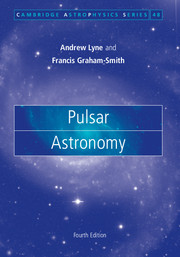Book contents
- Frontmatter
- Contents
- List of illustrations
- Preface
- 1 The discovery of pulsars
- 2 Neutron stars
- 3 Telescopes and techniques
- 4 The distances of the pulsars
- 5 Pulsar timing
- 6 Timing and astrometry of binary pulsars
- 7 Timing irregularities
- 8 The Galactic population of pulsars
- 9 The Crab and Vela Pulsars
- 10 Other young pulsars
- 11 Millisecond and binary pulsars
- 12 Accretion-powered X-ray pulsars
- 13 Magnetars
- 14 Supernovae and their remnants
- 15 Integrated pulse profiles
- 16 Individual pulses
- 17 Location of emitting regions
- 18 Radiation processes
- 19 The emission mechanisms
- 20 Interstellar scintillation and scattering
- 21 The interstellar magnetic field
- 22 Achievements and prospects
- References
- Index
19 The emission mechanisms
Published online by Cambridge University Press: 05 March 2012
- Frontmatter
- Contents
- List of illustrations
- Preface
- 1 The discovery of pulsars
- 2 Neutron stars
- 3 Telescopes and techniques
- 4 The distances of the pulsars
- 5 Pulsar timing
- 6 Timing and astrometry of binary pulsars
- 7 Timing irregularities
- 8 The Galactic population of pulsars
- 9 The Crab and Vela Pulsars
- 10 Other young pulsars
- 11 Millisecond and binary pulsars
- 12 Accretion-powered X-ray pulsars
- 13 Magnetars
- 14 Supernovae and their remnants
- 15 Integrated pulse profiles
- 16 Individual pulses
- 17 Location of emitting regions
- 18 Radiation processes
- 19 The emission mechanisms
- 20 Interstellar scintillation and scattering
- 21 The interstellar magnetic field
- 22 Achievements and prospects
- References
- Index
Summary
More than 40 years after the discovery of pulsars, and despite many attempts to assemble and analyse the very detailed observational data, it is still not possible to give a clear exposition of the processes by which pulsars emit beams of radio waves. The later discovery of intense gamma-ray emission has proved more amenable to analysis, and the observed characteristics can be related to the particle energies and the geometry of the magnetosphere. In both radio and gamma emissions, the source of energy is the enormous electric field which is induced by the rapid rotation of the highly magnetised neutron star. This electric field accelerates electrons and positrons to high relativistic energies; this occurs in two emission regions, involving respectively the open field lines close to the polar cap, and the outer gap. The high-energy photons emitted from the outer gap are curvature or synchrotron radiation from these primary relativistic particles; in contrast, the radio emission from both regions is coherent emission from a plasma created by the primary particle stream.
The two locations
The rapid rotation and strong dipole field of a typical pulsar give a maximum available potential of order 1014–1015 volts. In a fully developed, co-rotating and static magnetosphere this would be shielded by the electrostatic field of the charged particle density nGJ, as envisaged by Goldreich and Julian.
- Type
- Chapter
- Information
- Pulsar Astronomy , pp. 267 - 278Publisher: Cambridge University PressPrint publication year: 2012

